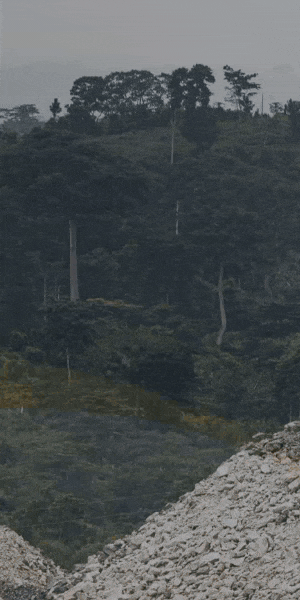Azimut Exploration Advances One of Canada's Largest Antimony Systems With Dual Gold Potential in Quebec

Azimut transitions to developer focusing on Quebec gold: Fortin Zone antimony system, Rosa high-grade discovery, Elmer resource. KGHM funds Kukamas nickel. Assays due Q4/Q1.
- Azimut Exploration is transitioning from project generator to development company, focusing on advancing three key 100%-owned gold discoveries: Wabamisk - Fortin Zone (antimony-gold), Rosa Zone (high-grade gold), and Elmer (resource-stage gold project)
- The Fortin Zone hosts one of Canada's largest antimony systems, spanning 1.8+ kilometers with 50-meter-wide mineralized envelopes tested to 250 meters depth, with metallurgical testing underway and dual antimony-gold potential
- Rosa Zone represents a breakthrough discovery with 300 meters of high-grade outcropping gold correlating to 1.4-kilometer IP anomaly, featuring widespread visible gold including coarse gold and fine gold dust in quartz vein networks
- Kukamas nickel-copper-PGE project advancing with KGHM partnership has identified seven ultramafic flows forming kambalda-type system with grades up to 19.6% nickel and 15 g/t platinum-palladium, with 4,000-meter drill program completed
- Company simplifying portfolio to focus on best discoveries while maintaining strategic partnerships with KGHM, Rio Tinto, and SOQUEM on other projects, with scoping study advancing on Elmer-Patwon resource
Azimut Exploration is undergoing a significant strategic transformation, evolving from a prospect generator model into a development-focused explorer advancing multiple discoveries toward resource definition and feasibility studies. Jean-Marc Lulin, president and CEO with 40 years of worldwide mineral exploration experience, outlined this evolution and provided detailed updates on the company's key projects during a comprehensive interview. The discussion reveals a company at an inflection point, with several advanced projects showing potential for substantial value creation in Quebec's prolific mining districts.
Strategic Evolution and Business Model Transformation
The company's strategic pivot represents a fundamental shift in how Azimut approaches its project portfolio. "When you are involved in exploration, the very key first step is to be at the right location," Lulin explained, noting that the company's systematic approach to database processing enabled the transition from generating projects to making discoveries. The CEO emphasized that
“Azimut is not considering itself as a project generator company now but much more a development company to advance to the resource stage, to the PEA stage on the very best discoveries it made."
This transformation involves portfolio rationalization, with Azimut focusing on three 100%-owned gold projects: the Wabamisk gold discovery (including the Fortin Zone and Rosa Zone) and the Elmer discovery. The company maintains strategic partnerships on other projects, including the Kukamas nickel-copper-PGE project with KGHM, and projects with Rio Tinto and SOQUEM. "We have to clean up our portfolio, focus on two or three projects where we have made discoveries," Lulin stated, emphasizing the company's commitment to becoming more focused and attractive to new investors.
The Fortin Zone: Canada's Emerging Antimony Giant
The Fortin Zone discovery represents one of Canada's most significant antimony systems, driven by what Lulin described as "a huge strong regional scale antimony anomaly in lake-bottom sediments." The discovery progression illustrates Azimut's systematic exploration approach. An isolated antimony prospect grading 2.7% antimony couldn't explain the massive regional anomaly, prompting focused follow-up work. Within two days of prospecting after regaining 100% project ownership, the team discovered new showings with 25% antimony grades - ten times the previously known mineralization.
Systematic channel sampling and stripping confirmed the extensive nature of the system. Drilling to date totals 12,000 meters across 86 holes, defining a mineralized system with at least 1.8 kilometers of strike length, open both to the west and east, and completely open at depth. The system has been tested to 250 meters vertical depth with strong mineralization continuing.
"We're talking about a wide continuous mineralized envelope very likely with ore shoots at higher grades, higher than 1% but the overall system is a large one."
The project targets both antimony and gold potential through understanding vertical zonation patterns observed in historical antimony mines, where gold-rich zones develop at depth below antimony-rich zones. "We already know significant gold grades at surface or sparse high-grade gold related to antimony grades," the CEO explained. Metallurgical testing is currently underway with SGS, with preliminary results described as encouraging - a critical factor for any antimony project's economic viability.
The aggressive 2026 program will pursue dual objectives: better defining the antimony deposit's size and exploring the vertical zonation to target deeper gold mineralization. The timing aligns with strong antimony market fundamentals, with the critical mineral experiencing significant price appreciation due to supply constraints and strategic importance.
Interview with Jean-Marc Lulin, CEO of Azimut Exploration
Rosa Zone: High-Grade Gold Discovery with Visible Gold
The Rosa Zone represents perhaps Azimut's most unexpected discovery. In an area with recorded exploration dating back to 1935 and previous involvement by 11 different companies, Azimut identified an outcropping, strongly mineralized gold-bearing zone with abundant visible gold that had never been recognized.
"This has been a big surprise to have an outcropping zone extensive with a lot of visible gold never recognized before. [This discovery provides] immense confidence about the potential of everything we already know around it."
The discovery began with a 1.3 gram per tonne grab sample that prompted additional prospecting, revealing 200 meters of almost continuous outcrops delivering visible gold, with an additional 100 meters of strike extension, totalling 300 meters of high-grade gold results. Critically, this high-grade outcropping gold correlates strongly with induced polarization (IP) geophysical anomalies showing chargeability and resistivity signatures. The IP anomaly extends 1.4 kilometers along the same axis, open at both ends, with 700 meters already defined by gold-bearing outcropping prospects.
Initial drilling returned coherent results with surface observations, with 11 of 26 holes showing visible gold. The visible gold manifests as both coarse gold and extremely fine gold dust around the coarse gold in quartz vein networks, including shear veins, flat veins, and extensional veins. The mineralization relates to metasedimentary rocks, which Lulin believes "may be a very good system for pervasive mineralization."
Assay results from the drilling program were pending at the time of the interview, expected by year-end 2025 or early January 2026. These results are crucial not only for shareholders but for planning the next exploration phase. The system's thickness and envelope remain incompletely defined, with recent drill holes showing visible gold outside the main IP anomaly axis, potentially related to a wide zone with strong resistivity to the south.
The 15-kilometer gap between the Fortin Zone and Rosa Zone contains numerous positive indications, opening significant exploration potential across the broader Wabamisk property. This district-scale perspective represents a major reframing of the project's potential.
Elmer-Patwon: Resource-Stage Gold Project Advancing
The Elmer-Patwon project represents Azimut's most advanced asset, with an existing resource defined using a $1,800 per ounce gold price. With current gold prices substantially higher, the resource base effectively expands before any additional drilling. A scoping study is well advanced, and the company has acquired additional claims to the west showing promising early-stage results.
"We have many good drill targets" for expanding the resource base, Lulin noted, emphasizing that the existing gold-bearing resource "is not limited by barren holes." This suggests relatively straightforward opportunities to expand the resource through step-out drilling along strike. Beyond simple resource expansion, the company has identified additional targets that may host copper-silver-gold mineralization further west and east.
Lulin drew parallels to the Val-d'Or mining district, where deposits that initially appeared modest were transformed through sustained drilling programs.
"At some point you have the ability with additional money to put 10,000-20,000 additional drilling and you are just like changing the view of everybody about this small resource. It's exactly the way we see Elmer."
Kukamas Nickel-Copper-PGE Project: Kambalda-Type System Emerges
The Kukamas project, operated by Azimut, and in partnership with KGHM, has revealed an exceptional high-grade nickel-copper-platinum-palladium discovery. Initial drilling delivered spectacular grades up to 19.6% nickel and 15 grams per ton combined platinum and palladium with other platinum group elements. The geological understanding of the system has evolved significantly, with mapping identifying seven separate ultramafic flows of komatiite composition.
"We know that we are dealing with a Kambalda-type nickel deposit which is one of the largest highest grade nickel camp in Western Australia," Lulin explained, adding that this system type is "fairly unique for Quebec." The 40-kilometer-long property remains largely underexplored, with potential for additional zones along strike and within multiple parallel ultramafic flows. A recently completed 4,000-meter drill program with 14 additional holes has assays pending, with results expected to guide the next phase of exploration.
KGHM has nearly completed its $5 million expenditure to earn 50% interest in the project and is expected to proceed with the second option to earn an additional 20% by delivering a preliminary economic assessment within two to three years. Azimut may remain operator throughout this progression. Beyond the nickel potential, the property also shows promise for gold-rich massive sulfide mineralization, identified through summer mapping programs that revealed a "very fertile environment."
Capital and Execution Strategy
Addressing the challenge of advancing multiple discoveries simultaneously, Lulin emphasized technical discipline over aggressive capital deployment.
"We want to advance as quickly as possible but in a rational way which is not excluding speediness."
The company maintains that it is "technically driven" and acts rationally, with money never having been an issue for deploying appropriate resources at the right time.
The team's experience and passion underpin this approach. "Enthusiasm and belief is not lacking in the team, we are believers who are passionate," Lulin noted. The company plans to provide detailed program guidance in Q1 2026, following the receipt of critical assay results from Rosa and continued results from the Fortin Zone.
The Investment Thesis for Azimut Exploration
- Strategic transformation from project generator to focused developer concentrating on three high-potential, 100%-owned gold discoveries in proven Quebec mining districts
- District-scale Wabasmisk system encompasses both the Fortin Zone (1.8+ km antimony-gold system open in multiple directions) and Rosa Zone (1.4 km IP anomaly with 700 m of high-grade outcropping gold), with 15-kilometer gap between zones offering additional exploration potential
- Antimony market timing positions Fortin Zone as one of Canada's largest antimony systems during period of critical mineral supply constraints and elevated prices, with metallurgical testing underway validating processing potential
- High-grade visible gold discovery at Rosa Zone in area explored for 90 years by 11 previous companies demonstrates potential for overlooked value, with widespread coarse and fine visible gold in outcropping mineralization correlating to extensive geophysical targets
- Near-term catalysts include assay results from Rosa Zone drilling (expected year-end 2025/early 2026), additional results from 14 Zone's 12,000-meter program, and Kukamas assays from 4,000-meter program testing kambalda-type nickel system
- Resource expansion pathway at Elmer-Patwon benefits from higher gold prices re-rating existing resource and clear drill targets for expansion along strike in established Val-d'Or mining district
- Portfolio rationalization strategy focuses capital and management attention on highest-value discoveries while maintaining leveraged exposure to partner-funded projects
Macro Thematic Analysis
Quebec is experiencing a mining renaissance driven by critical mineral demand, favorable geology, and supportive regulatory frameworks. Antimony's designation as a critical mineral has elevated its strategic importance amid supply chain vulnerabilities, while gold's continued strength reflects monetary uncertainty and central bank demand. Azimut's portfolio captures both themes through the Fortin Zone's antimony-gold system and Rosa's high-grade gold discovery.
The company's systematic approach in established districts reveals how modern exploration techniques can uncover significant deposits in supposedly mature regions. Strong commodity fundamentals, infrastructure advantages, and established First Nations relationships position Quebec explorers to capitalize on the energy transition and monetary system evolution driving metals demand.
"Good exploration leads to reveal an unrecognized highly favorable environment. We must believe in our ability to uncover brand new systems unrecognized before and it's what we have proven."
TL;DR: Executive Summary
Azimut Exploration is transitioning from prospect generator to development company, focusing on three 100%-owned Quebec gold discoveries: the Fortin Zone (one of Canada's largest antimony systems at 1.8+ km strike with gold potential), Rosa Zone (high-grade outcropping gold discovery with widespread visible gold across 1.4 km IP anomaly), and resource-stage Elmer-Patwon project. Near-term catalysts include Rosa assays (expected year-end/early 2026) and continued drilling results, while KGHM partnership advances high-grade Kukamas nickel-copper-PGE discovery toward PEA, with Azimut maintaining operator status and no funding obligations.
FAQ's (AI Generated)
Analyst's Notes




Subscribe to Our Channel
Stay Informed


































